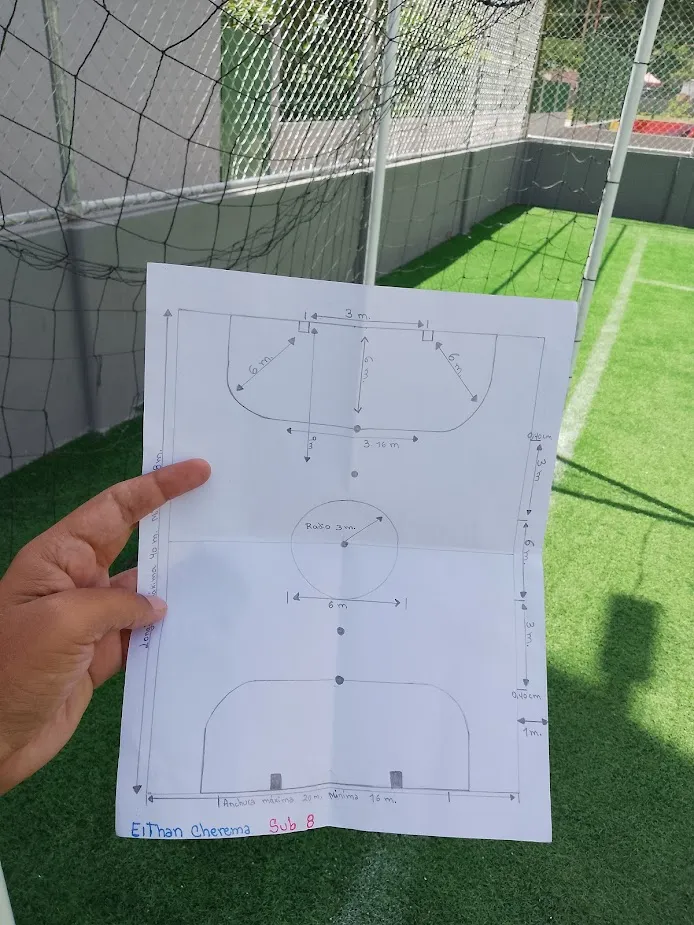La semana pasada, les propuse a mis alumnos un reto un tanto inusual: dibujar la cancha de fútbol sala con sus medidas exactas. Quería que, más allá de los entrenamientos y los partidos, comprendieran que el fútbol sala es mucho más que patear un balón.

Fue emocionante ver cómo el 80% de mis jóvenes futbolistas se involucró en esta tarea. Algunos la plasmaron en coloridos dibujos, otros en esquemas más técnicos, pero todos demostraron un interés genuino por entender el espacio en el que se desarrolla su deporte favorito.


¿Por qué esta tarea? Porque quiero que mis alumnos se den cuenta de que el fútbol sala es un juego de estrategia, de inteligencia y de conocimiento. No basta con ser el más rápido o el más fuerte. Es fundamental conocer las reglas, las medidas de la cancha y entender cómo se relacionan las diferentes zonas del campo.
Cuando un jugador conoce a fondo las dimensiones de la cancha, puede tomar mejores decisiones en el juego. Sabe cuándo es el momento de acelerar, cuándo es mejor pasar el balón y cómo aprovechar los espacios libres. Además, al dibujar la cancha, los alumnos están visualizando el juego de una manera más clara, lo que les permite anticipar las acciones de sus compañeros y rivales.
Esta actividad también nos permitió hablar sobre la importancia de la concentración y la precisión. Dibujar las líneas de la cancha con las medidas exactas requiere atención y cuidado. Estas mismas cualidades son fundamentales en el fútbol sala, donde una pequeña imprecisión puede cambiar el rumbo de una jugada.


En definitiva, quiero que mis alumnos sean futbolistas completos, que no solo se destaquen por sus habilidades técnicas, sino también por su comprensión del juego. Y estoy convencido de que esta tarea, aparentemente sencilla, ha sido un primer paso en ese camino.
Last week, I set my students a somewhat unusual challenge: to draw the indoor soccer field with its exact measurements. I wanted them to understand, beyond training and matches, that futsal is much more than just kicking a ball.

It was exciting to see how 80% of my young soccer players got involved in this task. Some of them captured it in colorful drawings, others in more technical diagrams, but all showed a genuine interest in understanding the space in which their favorite sport takes place.


Why this assignment? Because I want my students to realize that futsal is a game of strategy, intelligence and knowledge. It is not enough to be the fastest or the strongest. It is essential to know the rules, the measurements of the court and to understand how the different areas of the field are related.
When a player knows the dimensions of the court in depth, he can make better decisions in the game. He knows when it is time to accelerate, when it is better to pass the ball and how to take advantage of free spaces. In addition, by drawing the court, the students are visualizing the game in a clearer way, which allows them to anticipate the actions of their teammates and opponents.
This activity also allowed us to talk about the importance of concentration and precision. Drawing the lines of the field with exact measurements requires attention and care. These same qualities are fundamental in futsal, where a small inaccuracy can change the course of a play.


In short, I want my students to be complete soccer players, who not only stand out for their technical skills, but also for their understanding of the game. And I am convinced that this seemingly simple task has been a first step on that path.

Tomadas desde mi celular Motorola G4
Traducción al ingles desde DeepL
Taken from my Motorola G4 cell phone
English translation from DeepL